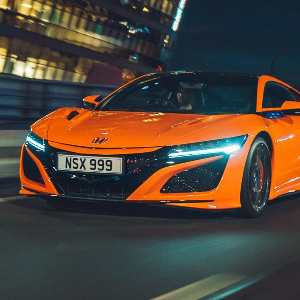
Andrew English finds out whether the Ferrari Roma is more than just a Portofino with a hard top.
They named checked La Dolce Vita several times at the launch of the Roma, Ferrari’s latest V8 gran turismo. Federico Fellini’s eponymous 1960 movie was a sharp witted, Oscar- and Palme d’Or-winning satire on the behaviour of political establishment, show business and the aristocracy in the post-war Rome and Italy in general.
It was a slightly clod hopping way of linking the new Roma with the eternal city and a purple period for Ferrari coupés: the 195 Inter and S, the 340 America, the 250 GT range and the 410 Superamerica amongst others. The Roma was even launched in Rome last year, though for the launch, the company cobbled together a series of roads and hotel in the Langhe area of Piedmont in North West Italy. At a time when German car makers are still working out how to get UK journalists to even see their new cars, this was a creditable attempt to return to business as usual for the car industry.
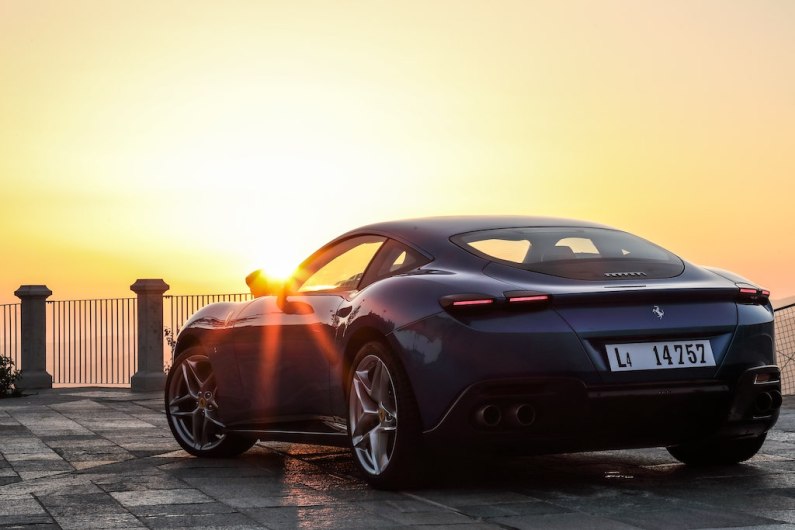
For those of you wondering, Ferrari continues to build the £263,098 812 Superfast, which is arguably a more old-school 789bhp V12 coupé, but Roma has created such a buzz of interest since it was first mooted, it was difficult to see how Ferrari couldn’t build it. But is it just a Portofino with a fixed roof? Well yes and no. Yes because it uses a similar base and engine, no because the proportions are so different. Put simply, Roma is wider and has a lower centre of gravity, which means its static dynamics start from a better place. A Portofino weighs 1,664kg, the Roma has a stated weight of 1,570kg, but there’s a catch. To get the weight down to that figure the Roma has to be specified with over £25,000s worth of carbon fibre and Alcantara trim options.
The driveline isn’t exactly the same as the Portofino’s either. The 3,855cc, 90-degree splayed, quad-cam biturbo V8 has high-lift cams, hollow valves and the turbos spin harder, which means it’s more powerful from earlier on. The eight-speed twin-clutch gearbox comes from the SF90 Stradale rather than the seven-speed item from the Portofino. There’s different suspension rates and settings for the electronically powered steering system and an optional magnetorehological damper set up (£3,168), which was fitted to our car.

First impressions are of a gloriously curvaceous GT in the classic manner. Get up close, however and the looks aren’t quite as wonderful as they looked as you were walking up; front to rear it’s lovely, side to side, not quite so much. Getting this sort of new/old GT right is really difficult and can often result in highly derivative looks; Henrik Fisker’s BMW Z8 for example. From the back the Roma resembles Ian Callum’s F-type design, from the front there’s a fair bit of TVR Sagaris and that body coloured perforated radiator grille takes a lot of getting used to. They only got away with it thanks to the lower cooling requirements of the eight speed transmission and there’s a lot of trick aerodynamics on the car including down-force generators, flip-up spoilers, tail venturi and an outrageously cut off Kamm tail.
Why Roma? “It’s our most beautiful city,” says Marco Bai, marketing production manager for the Roma. “It’s for people looking for an everyday car to be used in the city centre and out of town at the weekends,” he adds. “Roma is a modern take on the gentleman drivers’ cars of the Fifties and Sixties,” he boasts… “As for gentlemen drivers and whether they are women or men, well, that’s another question.”
Whether this £170,984, 612bhp road rocket is a perfect city car at all is also another question, but inside it’s charmingly designed, opulent and has a lot of high tech, almost too much of it.
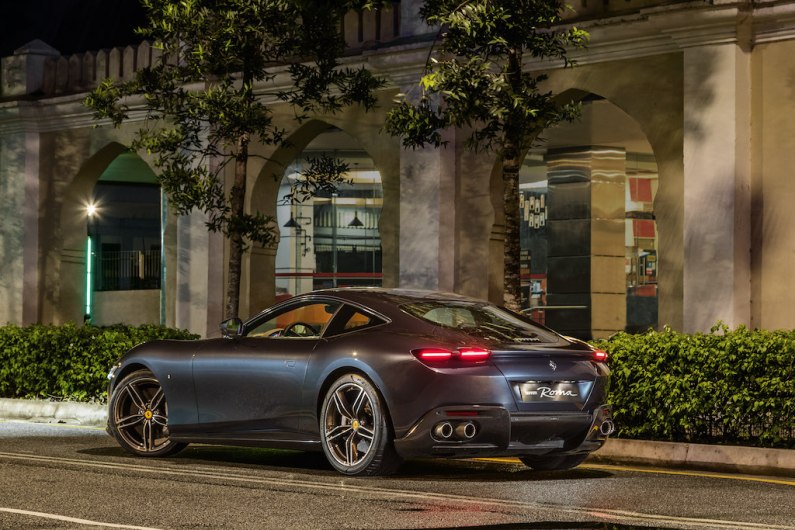

The facia design is based on frequency of use, where the most commonly used functions are the closest to hand, which means the little used functions are hidden away and as impossible to find as a squirrel’s autumn cache of hazel nuts. And there are some barmy juxtopositions of digital and mechanical, such as the steering-wheel Manetino, which dials in ever-more extreme chassis and engine settings. The switch has no markings so you turn it and after creaky delay, a flag appears on the digital instrument binnacle, obscuring the navigation instructions, to tell you what you’ve selected. There’s also a voice control system, which takes over if you are unwise enough to murmur “Ciao Ferrari” and is most reluctant to go away.
Control of the systems relies on capacitive touch pads on the steering wheel, which don’t always register your intentions and there’s also the ‘Twin Cockpit’ display in front of the passenger.
For all the moans, however, the Ferrari’s basics are good. The driving position is excellent, the seats are brilliantly comfy and supportive, and vision out of the front is good, though the rear-view mirror isn’t terrific and over-shoulder views are restricted. It’s a two-plus-two, which means the rear seats are suitable for shopping bags rather than people and at 272 litres the boot isn’t exactly huge, but provided you aren’t carrying the pantomime horse and the lighting rig, there’s room enough for a weekend’s luggage for two in there.
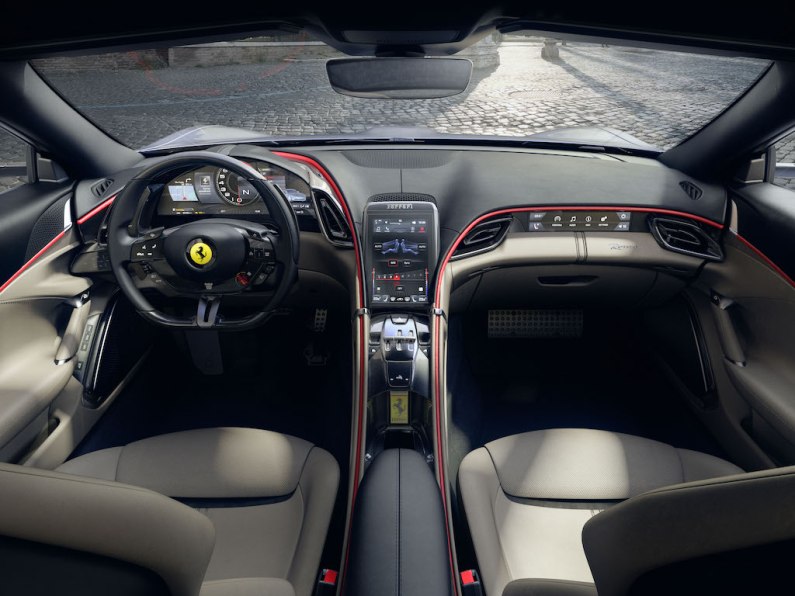
Like all these large-capacity turbo mills, the Ferrari sounds like a leaf blower at idle, though it gains some audible portent above 3,000rpm. Forget what you knew about turbo lag, however. Press the throttle at virtually any speed and the effect is like a match in the ship’s magazine; boom! The nose rises and the horizon is sucked into that medieval knight’s grille. Overtaking is absurdly simple, just pull on the left-hand steering column paddle, the eight speed drops a ratio and whoosh, you’re past; you really need a superlative sense of responsibility to drive a super car like this.
As befits a grand tourer, the Roma also cruises quietly at 70mph plus and doesn’t seem to be too thirsty as long as you leave the turbos alone. It didn’t really need an eight-speed transmission, but the ratios are stacked close, so you can play tunes by short shifting up and down. This is also the first V8 Ferrari to have a Race mode setting, which sharpens the changes to the point of brutality, although even around town the gearbox thumps into gear especially on the way down ratios.
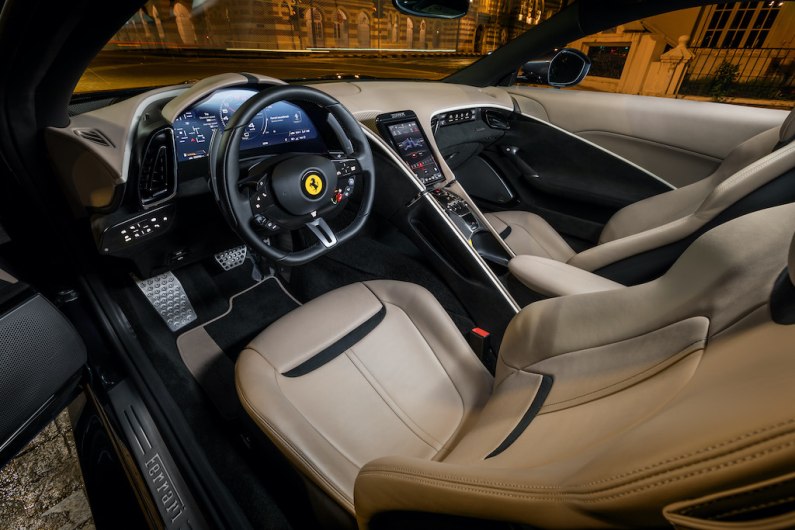
That’s the only gripe in town, though, since with better proportions and suspension geometry, the Roma’s wheel spring rates don’t have to be so high to get the same kind of handling agility. So the ride is really quite good, feeling more compliant and comfortable than the Portofino. There was, however, an annoying choppiness about the damping, particularly at the rear and on the autostrada the Roma never felt fully settled.
Those minor roads were dry, but unpredictably slippery and in places treacherous. The Wet setting on the Manetino reined in impending slides efficiently, but the middle settings Comfort and Sport (which are almost the same) seemed slow to recover a wheelspin. Race was more brutal, but the more direct reactions to the major controls and sharper throttle mapping allowed better communication from the chassis. The nose feels a bit soft on turn in and the steering doesn’t have much feedback until you’ve turned the wheel a bit. Once in the corner the Roma settles, but it felt as though there was a bit too much diagonal pitching and load transfer to the outside front wheel, which reduced the load on the inside rear. Raffaelle de Simone, Ferrari’s chief test driver explained that the Roma’s long-travel suspension allows it to have more body movement like this without compromising grip and traction, but those roads were so unpredictable and slippery it was difficult to draw absolute conclusions, even if the basically good dynamics of the Roma allowed a quick recovery from the slides.
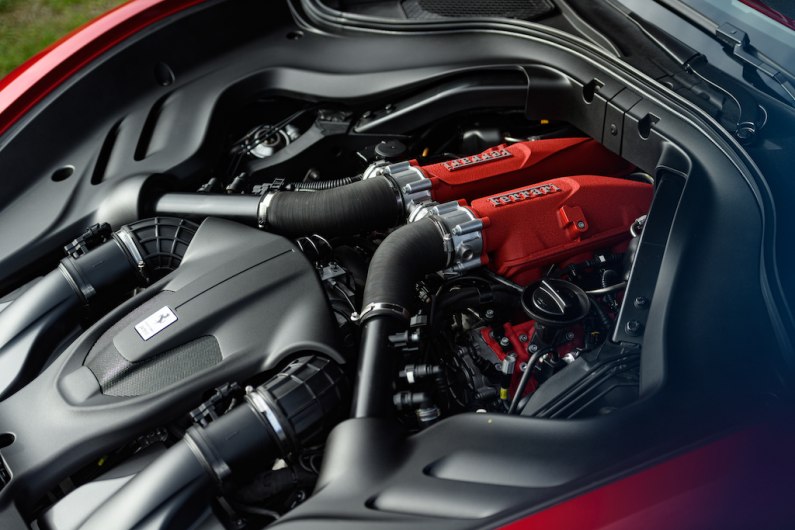
On better (and wider) roads, the Ferrari felt more surefooted and confidence inspiring, with all the traditional advantages of a front-engined car (safer cornering traits, which are intuitively corrected) but few of the drawbacks (a lack of agility and stodgy nose-on understeer). Rivals include Aston Martin’s Vantage (and DB11), the Mercedes-AMG GT coupé and Jaguar’s F-Type coupé and while the Roma is expensive in this company (when has a Ferrari been anything but?), it is a consummate GT; refined, fast and good looking even if it isn’t quite as gorgeous as Ferrari would have it. So it’s business as usual in Maranello and I’ll wager the Roma will go down as another great front-engined Ferrari.
Model: Ferrari Roma
Price: £170,984
Engine: 3,855cc, twin-turbo V8 petrol
Power: 612bhp @ 5,750rpm
Torque: 760Nm @ 2,200rpm
0-62mph: 3.4 seconds
Max speed: 199mph
WLTP Fuel consumption: 25.2mpg
WLTP CO2: 255g/km
